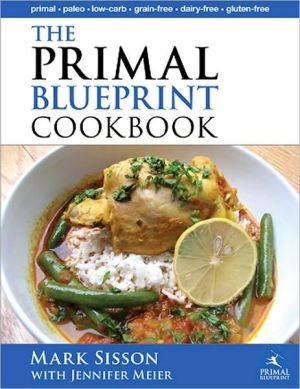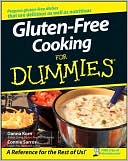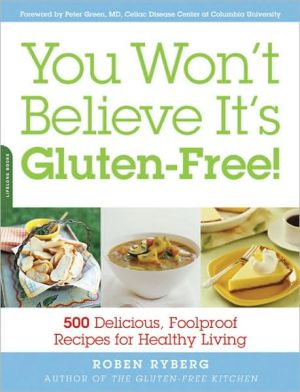Gluten-Free Gourmet: Living Well without Wheat, Second Edition
An updated, beautifully designed edition of the essential resource for people who cannot tolerate wheat or gluten.\ With her four cookbooks, Bette Hagman has brought tasty food Whack into the lives of over one million people who are intolerant of the gluten in wheat, oats, barley, or rye, or who are allergic to wheat. The premier creator of delicious gluten-free fare, Hagman has spent more than twenty years developing recipes using special flours for pizza, pasta, breads, pies, cakes, and...
Search in google:
An updated, beautifully designed edition of the essential resource for people who cannot tolerate wheat or gluten.With her four cookbooks, Bette Hagman has brought tasty food Whack into the lives of over one million people who are intolerant of the gluten in wheat, oats, barley, or rye, or who are allergic to wheat. The premier creator of delicious gluten-free fare, Hagman has spent more than twenty years developing recipes using special flours for pizza, pasta, breads, pies, cakes, and cookies. Containing over 200 recipes updated to include new flours, ingredients, and tips, the second edition of The Gluten-free Gourmet makes cooking gluten-free faster and more fulfilling than ever before. The Gluten-free Gourmet is more than just recipes, however. A complete sourcebook on how to live healthily with celiac disease or wheat intolerance, it features important new information on developing a celiac diet, raising a celiac child, avoiding hidden glutens, eating well while traveling or in the hospital, and locating and ordering from suppliers of gluten-free food and flour. This and Hagman's other books in the Gluten-free Gourmet series are recognized by health newsletters around the world as the best in this special diet category. Library Journal The more than 100,000 Americans allergic to wheat are usually deprived of Sourdough Bread, Butterscotch Brownies, and all the other favorite dishes Hagman has created without using gluten. Her recipes use flours other than wheat flour, but they are generally uncomplicated and quick to prepare--suitable even for those noncooks who have been craving their forbidden foods. There are few other cookbooks in this area; recommended for all special collections.
The Gluten-free Gourmet, Second Edition\ Living Well Without Wheat \ \ By Bette Hagman \ Holt Paperbacks\ Copyright © 2000 Bette Hagman\ All right reserved.\ ISBN: 9780805064841 \ \ \ Gluten-Free Gourmet Revised Ed\ A Diet for LifeWhen I left my doctor's office over twenty-five years ago clutching three smudged photocopied pages, I was sure that he, like all the other physicians over the years, was just trying to mollify one more skinny hypochondriac. How could a simple diet relieve me of years of bloating, gas, pain, and bouts of diarrhea? I had never heard of nontropical sprue, the term he gave my disease.One week later I called his office. "You're a genius. I feel better already.""Just stick to that gluten-free diet and call me back when you start gaining some weight."By the end of the month I'd read everything I could find (and that wasn't much) about my condition, which had several names: nontropical sprue, celiac sprue, gluten sensitive enteropathy, and, finally, celiac disease. The symptoms were familiar--bloating, diarrhea, backaches, and often just plain stomachache. Others seemed to have constipation with their bloating, and others were only anemic. Another gluten-intolerant condition had symptoms of burning blisters, bumps, or lesions. It has just been in the last decade that those patients with DH (dermatitis herpetiformis) are considered celiacs and put on the gluten-free diet, for, when biopsied, they, too, show damage to the villi. This is really good news for these patients, although they may not consider it so at first, for they can usually reduce their medication slowly and most of them will be able to discontinue it completely as long as they stick to the diet.I also discovered that I was fortunate in having been diagnosed in the 1970s. Although physicians were aware of celiac disease long before that, until the 1950s there was no answer to what caused the distress symptoms. Many sufferers were limited to eating bananas and rice and were forbidden coarse foods such as other fruits, vegetables, and meat. It wasn't until after World War II that diets could be expanded, when doctors became aware that only the gluten in wheat, barley, rye, and oats was intolerable to patients with celiac disease.I soon realized, though, that with my improved health and renewed appetite, a diet without wheat, barley, rye, or oats was just plain boring. I didn't mind Cream of Rice for breakfast, but how could I live the rest of my life without bread or pasta or cake or stuffing in my turkey or ... The list became endless. One day I cheated and ate some freshly baked bread full of the forbidden glutens. The result of that spree was three days in bed suffering the same distress that had sent me to the doctor. I didn't tell him about my slip, but I resolved it would never happen again. Until medical science came up with a better cure for our disease, I'd stick to my diet. I also pledged myself to finding some way to make my food more interesting.Since I am the kind of noncook who left the plastic wrap on the corned beef the first time I tried boiling it and who had to look up the word sauté in the dictionary, I needed help. The health food stores had a couple of boxes of gluten-free baking mix, some rice and soy flours, and Hilda Cherry Hills's book Good Food, Gluten Free. Ms. Hills's book contained excellent advice on living, but frankly, the British recipes left me still searching for better taste.I found an organization called the Gluten Intolerance Group (GIG), which met at our local university school of medicine. Besides providing medical and dietary information, members exchanged cooking hints and recounted horror stories about their own years BD (before diagnosis). I learned I was not alone. In 1990 it was estimated there were over a hundred thousand celiacs in the United States. Even then it was suggested that this may only have been the tip of the iceberg, for many doctors miss the diagnosis--a patient may not recount all his or her symptoms because they sound so diverse. Even more confusing for the patient and the doctor is the fact that celiac sprue symptoms can mimic many other disorders.Very slowly the doctors are becoming more aware of the condition, and in 1997 nationwide blood screening was started for celiac disease. The iceberg is being slowly uncovered. The estimate is running closer to one million celiacs in the United States at this time. With the new and noninvasive blood tests just developed a few years ago, a doctor can screen patients with symptoms first before suggesting the more drastic endoscopy and biopsy. This is now advised for all first- and second-degree relatives of celiacs, for preliminary findings show that approximately 5.7 percent of first-degree relatives and 3.1 percent of second-degree relatives will test positive for the disease. Many of these may have no symptoms as yet, and getting on the diet early may save them from having any of the damaging effects of celiac disease. This damage can cause malabsorption of food and lead to possible anemia, malnutrition, calcium deficiency, mental and/or physical fatigue, or other problems.I was not aware of any of these possible problems, nor were most people in 1974, but finding that I was not alone with a "rare" disease made me look for more answers. Since then I have joined other celiac groups, become more informed via the increasing amount of literature and medical reports on celiac disease, and have attended national and local conferences in both the United States and Canada. A speaker at one of those conferences described our disease picturesquely: The celiac's immune system mistakes gluten for an enemy and, while fighting it in the gut, flattens or blunts the villi. A healthy villi can be compared to a shag carpet in the intestines soaking up nutrients: the celiac gut resembles linoleum, allowing nutrients to slide unused to the exit.At the time I was diagnosed, the only flour used for baking was rice, but I soon found that there were other tasty flours we could use: sweet rice, potato, potato starch, soy, tapioca, cornstarch, corn flour, cornmeal, and buckwheat. In the last ten years we've added flours from beans and sorghum, and several of the national organizations recognize that the flours and cereals of amaranth, quinoa, tef, and millet do not contain the toxic gluten. Canada has always considered them gluten-free and allowed them in their celiac diet.With this wide choice of flours I've discovered it is possible to make good breads, cakes, cookies, and casseroles. I've even baked pizza and lasagne successfully. I stuff my turkey at Thanksgiving and eat plum pudding at Christmas and hot cross buns at Easter. I feed the family and any guests using my diet, and they never suspect they are eating gluten-free foods. In fact, I am often asked for my recipes.Today the newly diagnosed celiac is more fortunate than I was twenty-five years ago. He or she can join national groups with a chapter nearby, has the choice of more cookbooks, and can find gluten-free bread and mixes in some health food stores or can order, by mail or phone, diet breads, rolls, cookies, gluten-free pasta, and even full main dishes.Scientists have made progress on the disease, but to date they have not come up with any way other than diet to stop the gliadin factor in gluten from damaging the small intestine. Staying on a gluten-free diet is still the only known way to regain health and remain in remission.Now I am not even impatient for science to discover some miraculous cure for our disease. With my weight back to normal and my energy high, I eat well within the limitations of the gluten-free diet. I don't think of it as a diet for life, I consider it a prescription for living.As with any prescription, it has to be filled, and the simplest way to do this is to join a support group--local or national--with a knowledgeable leader. Dieticians and nutritionists are still struggling to understand both cooking with the difficult flours and finding and eliminating hidden gluten, but anyone on the diet soon learns what he/she can have and is more than willing to share at meetings and in the many well-researched newsletters.There are also two national publications offering information about the disease and a site on the Internet. Caution: The Internet has become a sounding board with a lot of information, but this is not monitored so be selective about what you accept when you read it on the screen.For more information about celiac disease or to find a group near you, contact one of these national organizations: \ American Celiac Society Dietary Support Coalition, 59 Crystal Avenue, West Orange, NJ 07052-3570; (973) 325-8837Canadian Celiac Association, 190 Britannia Road East, Unit 11, Mississauga, Ontario L4Z 1W6, Canada; (905) 507-6208 or (800) 363-7296Celiac Disease Foundation, 13251 Ventura Blvd., Suite 1, Studio City, CA 91604-1838; (818) 990-2354; fax (818) 990-2397Celiac Sprue Association/United States of America (CSA/USA), P.O. Box 31700, Omaha, NE 68131-0700; (402) 558-0600Gluten Intolerance Group of North America (GIG), 15110 10th Avenue, SW, Suite A, Seattle, WA 98166; (206) 246-6652Internet: http://celiac@maelstrom.stjohns.edu http://rdz.acor.org/lists/celiac/index.html \ ReferencesCiclitira, P. J., Ph.D., F.A.C.P. (Rayne Institute, St. Thomas' Hospital, London.) "Vision for the Future." Lecture at Celiac Disease Foundation, spring 1992.Fasano, Alessio, M.D.; Berti, Irene, M.D.; Green, Peter H. R., M.D.; Not, Tarcisio, IRCSS, Garofolo: "Prevalence of Celiac Disease Among First and Second Degree Relatives in the U.S.A." Paper delivered at Digestive Disease Week, Orlando, Florida, 1999.Hamilton, Helen Klusek, ed. Professional Guide to Diseases. Springhouse, PA: Springhouse Corporation, 1987.Hartsook, Elaine I., R.D., Ph.D. "Celiac Sprue: Clinical Aspects and Patient Realities. What Is Celiac Sprue?" Paper delivered on Celiac Experience I cruise, 1991..-----"Dermatitis Herpetiformis." Paper delivered at the Gluten Intolerance Group of North America, 1993..-----"Gluten-Sensitive Enteropathy: Update for Health Care Professionals." Paper delivered at the Gluten Intolerance Group of North America, 1992.Hopkins, Randy, M.D. "Keeping Your GI Tract in Shape." Lecture at Ballard Hospital Campus, Seattle Center for Digestive Diseases, spring 1994.Kasarda, Donald, Ph.D. "Celiac Disease." Presentation at North American Society for Pediatric Gastroenterology and Nutrition, Toronto, Canada, October 1997.Katz, S. "Dermatitis Herpetiformis, The Skin and the Gut." In Annals of Internal Medicine 93, no. 6 (December 1980): 857-74.Murray, Joseph A., M.D. "Celiac Disease in the U.S.A.: Where We Are Vs. Where We Need to Be." Keynote address at annual meeting of the Gluten Intolerance Group of North America, March 1993..-----"The Widening Spectrum of Celiac Disease." American Journal of Clinical Nutrition 69 (1999): 354-65.Schuffler, Michael. "Medical Facts About Celiac Sprue--New Research." Address to the Gluten Intolerance Group, March 1981.Seely, Stephen; Freed, David L. J.; Silverstone, Gerald A.; and Rippere, Vicky. Diet-Related Diseases; the Modern Epidemic. London and Westport, CT: Croom Helm, AVI, 1985.Winkelman, Eugene I. "The Many Faces of Sprue." Address at CSA/USA national convention, October 1988.Zone, John J., M.D. "Dermatitis Herpetiformis." Lecture at annual meeting of the Gluten Intolerance Group of North America, spring 1992.Copyright © 1990, 2000 by Bette Hagman \ \ Continues... \ \ \ \ Excerpted from The Gluten-free Gourmet, Second Edition by Bette Hagman Copyright © 2000 by Bette Hagman. Excerpted by permission.\ All rights reserved. No part of this excerpt may be reproduced or reprinted without permission in writing from the publisher.\ Excerpts are provided by Dial-A-Book Inc. solely for the personal use of visitors to this web site. \ \
\ From the Publisher"The Gluten-free Gourmet offers delicious relief for anyone who is allergic to wheat and for those who are intolerant to the gluten found in wheat, oats, barley, and rye."—Bon Appetit\ \








